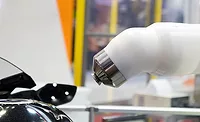How Can the Paint Industry Improve PSRA Compliance?

Product stewardship and regulatory affairs (PSRA) professionals handle the minimization of all negative environmental impacts, and follow the respective regulations for formulating, manufacturing, and distributing products responsibly. Many efforts that began as people did their best to meet PSRA compliance standards have now branched into extended producer responsibility (EPR) aims.
EPR relates to the end-of-life or disposal measures that allow consumers to throw away specific products with minimal environmental harm. In the paint industry, that typically means establishing user-friendly recycling programs. Here are some particular ways paint professionals can promote product stewardship and regulatory compliance within their industry.
Understand and Specify When Paint Is a Hazardous Material
Some paints are hazardous materials due to their flammability. For example, oil-based paints are categorized as hazardous for that reason, but that’s not generally true for water-based formulas. However, there could be other ingredients in or characteristics of water-based paint that make it hazardous.
Workplaces and other organizations that handle paint usually have specific disposal rules. However, the main thing to remember about oil-based formulas is that people cannot dispose of them in the trash. The usual approach is to tag them as hazardous and have them picked up by people qualified to take the next steps.
When paint is a hazardous material, it is the responsibility of representatives at the product’s origin point to specify that detail. That happens via the safety data sheet (SDS) provided by the manufacturer. The SDS contains the product’s hazard classification, along with handling details and what people should do in case of accidents.
Hazardous materials require special labels, packaging, handling, and storage for transit. Doing all those things, as mandated, will help people meet PSRA compliance standards because they’ll reduce the chances of mishaps occurring due to a lack of knowledge of the hazards.
PSRA Compliance Standards and Lead in Paint
In 2009, the United States set the allowable limit for lead in paint to 0.009%, although paint for bridges and marine use can have more. That’s a significant change from how things were several decades ago. White house paint used before 1955 had up to 50% lead. That changed as people learned more about the hazards of lead exposure over time.
More specifically, hazards began to be classified according to the associated blood lead levels (BLLs). However, research progressively showed lower BLLs still posed dangers to the affected individuals, which caused updates to regulatory requirements.
Also in 2009, The Global Alliance to Eliminate Lead Paint was established. This alliance is a collaborative effort where stakeholders from various industries voluntarily work together to make lead paint a thing of the past. Some initiatives involve working with governments to develop new laws limiting lead paint use. Others assist small and medium-sized businesses in overcoming the barriers that make it difficult for them to reformulate paints to remove lead-based additives.
Despite concentrated approaches like these, you may be surprised by how many issues with lead paint still exist. Many concern older homes built before the United States began placing stricter limits on lead in paint. For example, 80% of the homes built in Cleveland, Ohio, were erected before the federal government banned lead paint for residential use in 1978.
Cleveland City Council Members passed a 2019 law that required all landlords and property owners to ensure they had lead-safe abodes by March 2023. However, most have yet to comply. Professionals in the paint industry could help things move in the right direction by strategically promoting their lead-free offerings. By doing that, they’ll help others comply with paint-related laws.
Remain Aware of Relevant Progress
Fortunately, the paint industry has gradually become more sustainable, with professionals realizing that action now affects the future of the planet and its inhabitants. However, the improvements made over the years don’t solely relate to new formulations.
Sometimes, making improvements means embracing specific techniques. For example, powder coatings are a more sustainable choice than some others. The products used do not have solvents, and they release few or no volatile organic compounds (VOCs). Following PSRA compliance standards requires people to stay in the know about developments that matter to them.
Innovative Recycling Programs
The American Coatings Association (ACA) has engaged in legislative action that resulted in Maine and Oregon passing laws that could save the paint industry millions of dollars associated with plastic paint containers.
However, the laws go beyond the paint industry and its associated containers. For example, applicable manufacturers in Maine must pay into a fund depending on the amount and recyclability of their packages. Those contributions will reimburse municipalities for recycling program expenses, promote the development of improved recycling infrastructure, and more.
New York is another state leading the way in regards to PSRA compliance standards. The state launched a program in 2022 that makes it easier for households and businesses to properly dispose of paint. Drop-off locations will accept at least 5 gallons of paint. Moreover, customers wishing to discard more than 100 gallons can arrange pickups.
Vermont also has a municipal program that turns nearly half of received latex paint into new formulas. This Local Color collection includes 11 base colors with several associated shade choices.
These are some of the many examples of product stewardship that can support regulatory compliance and build a greener future. If professionals in the paint industry don’t create new programs, they can at least support some of these and make it easier for people to participate.
How Will You Uphold PSRA Compliance Standards?
These suggestions highlight how people can focus on product stewardship and regulatory affairs compliance standards in numerous ways. As decision makers narrow their plans, they should think about actions that will have long-term impacts, as well as those that will provide motivating quick wins.
Succeeding will help paint manufacturers and others in the industry show they’re forward-thinking and care about responsible operations. Many initiatives could even inspire peers to take similar actions, generating momentum and achieving far-reaching results.
The final thing to remember is that most initiatives take time to implement, particularly if they involve multiple parties, groups, or organizations. People must remember to be patient while doing their best to stick to well-developed plans that will keep things moving forward, instead of stalling.
Looking for a reprint of this article?
From high-res PDFs to custom plaques, order your copy today!






